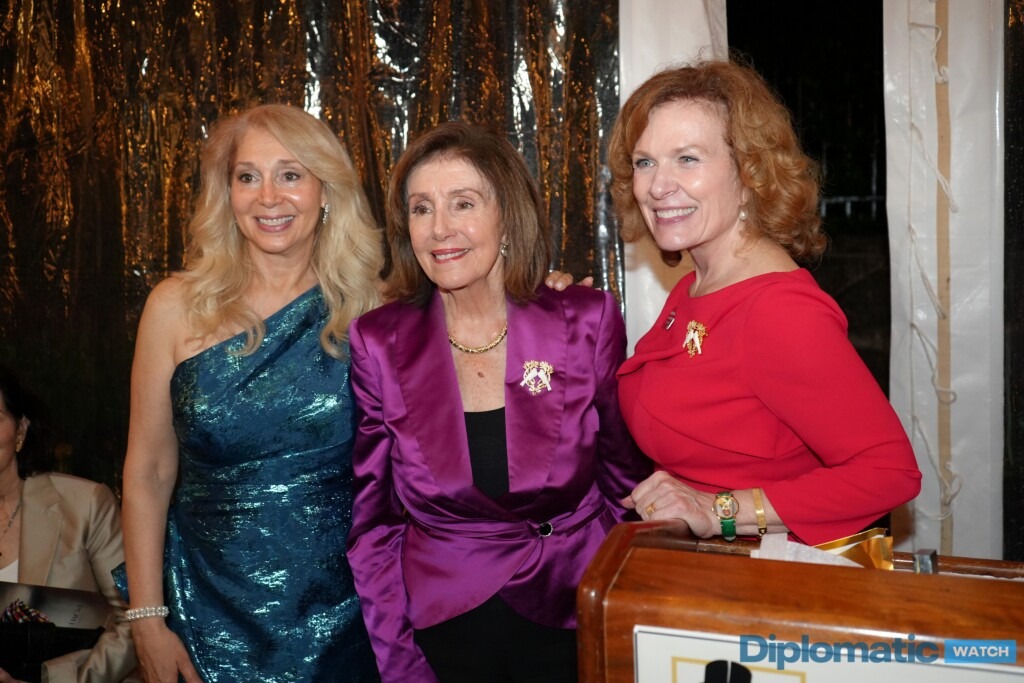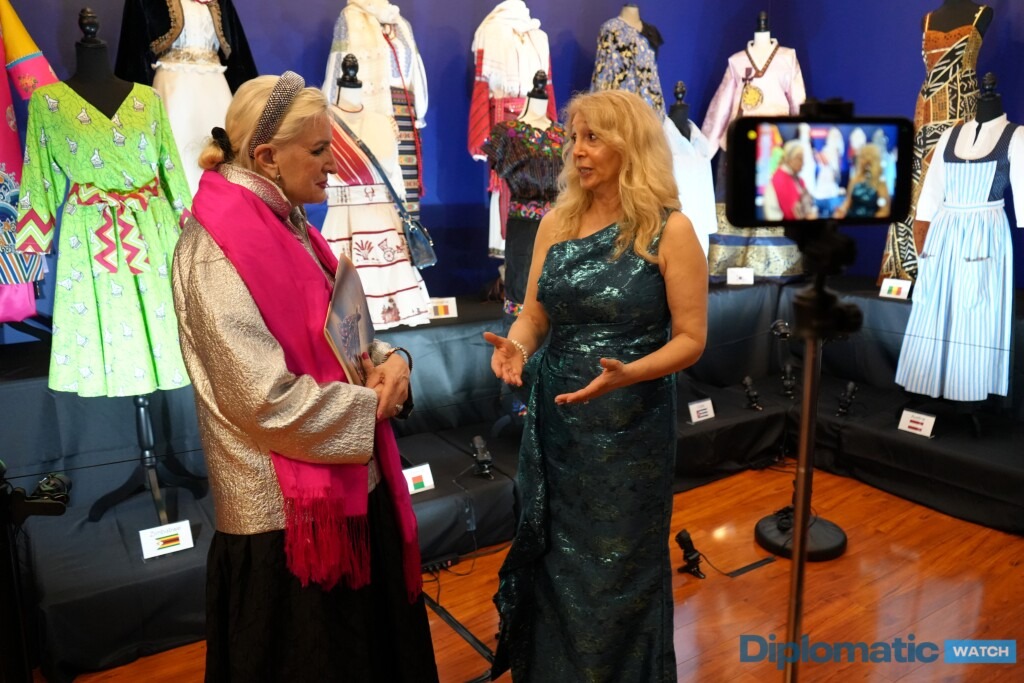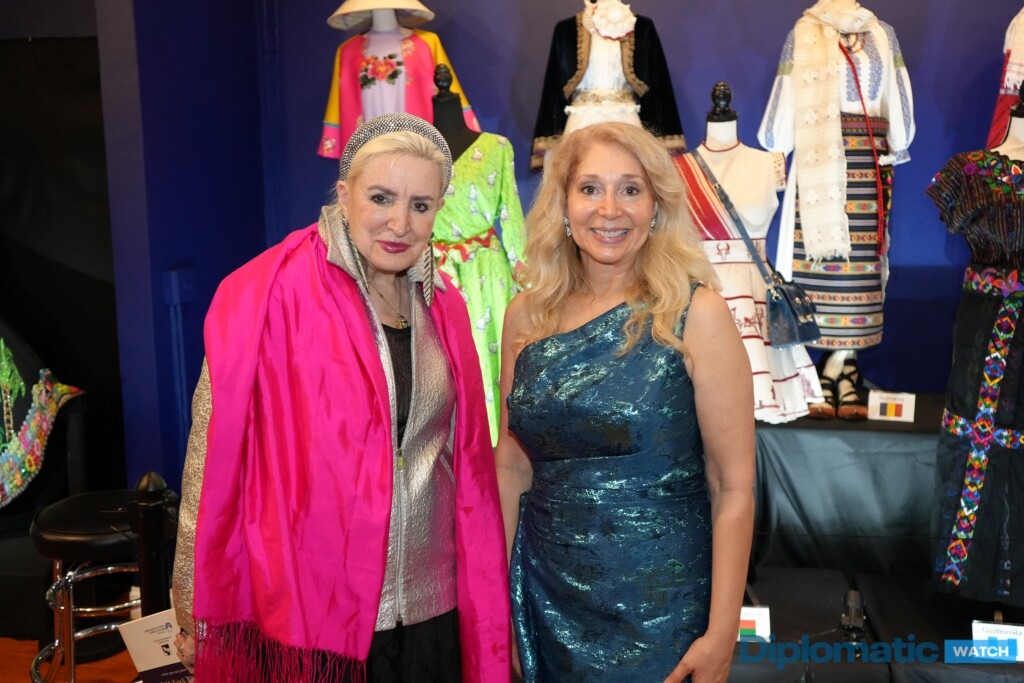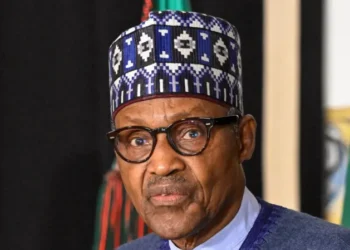In a distinctive convergence of diplomacy and fashion, Diplomatic Watch had the honor of covering an extraordinary evening titled “Fashioning Power, Fashioning Peace through Fashion” held at the historic Woodrow Wilson House in Washington, D.C. Representing the publication, Dr. Christine Warnke spoke with Janet Pitt, the visionary Founder and Chair of Diplomacy Matters LLC, who also chaired this unique diplomatic gathering.
The concept of fashion as a diplomatic tool was formally recognized in 2012 by then–UN Secretary-General Ban Ki-moon as part of the soft diplomacy toolkit. The idea of hosting such an event in Washington originated three years ago with Indira Gumarova, spouse of the former Czech Ambassador to the U.S. Janet Pitt, who served on Gumarova’s early planning committee, carried the vision forward after the couple’s transfer to Vietnam. In collaboration with Elizabeth Karcher, Executive Director of the Woodrow Wilson House, Pitt brought the concept to life through a diplomatic fashion exhibition and chaired this year’s edition of the event.
Janet Pitt’s work bridges cultures through fashion as a tool of soft diplomacy, bringing representatives from over 50 countries together in a shared space of mutual respect and cultural exchange. The event showcased traditional and contemporary garments—each with a story of diplomacy stitched into its fabric—from nations across the globe. From gowns worn by First Ladies to innovative designs by emerging talents like nine-year-old Max Alexander, the evening affirmed that diplomacy can take many forms—threads included.
Beyond fashion, Pitt’s mission remains focused on building meaningful connections among diplomats, Members of Congress, and Administration officials, encouraging cross-sector dialogue and cooperation through the broader lens of soft power.
With deep roots in public service and international affairs, Pitt has redefined how global dialogue can flourish through artistic expression. In this candid and colorful conversation, she shares the inspiration behind her vision, the significance of the Woodrow Wilson House, and the compelling stories behind the designs.

Christine Warnke: Janet, thank you for being here, and you have done an amazing job. With this tonight, can you talk a little bit about what you preserved with your vision and why you did it? Start from the beginning about what happened three years ago when you decided to start this.

Janet Pitt: We thought if you could have diplomacy through art, music, and sports, why not through fashion? It’s just another tool, another vehicle that we can use to bring people together. Tonight, for example, we had representation from 50 countries that were exhibited, and we got to see their fashion. But to me, the real bonus was, we got the Ambassadors and the Deputy Ambassadors from over 50 countries here together in one room where they could talk to each other, because that doesn’t happen very often. Fashion is the tool that brought them together. Fashion helps us to build bridges. It helps us to understand each other’s cultures, and it moves us towards peace.
Christine Warnke: It’s soft diplomacy at its best. It really is. And so tonight, there are so many amazing costumes. We are in a room tonight with the native costumes of all these countries. If I point them all out, it’s Bolivia, Paraguay, Zimbabwe, Madagascar, and etcetera. It’s amazing you have all of these beautiful pieces of art.

Janet Pitt: These are like originals. These are older native costumes of their country. Then when you go upstairs, you will see the more modern designers, and those are the gowns worn by First Ladies, Heads of State, and Diplomats. The designers, some of them are famous and some of them are less so. But there are stories behind each of them, and each country gave us the dress that they think symbolizes diplomacy. So, there is a dress from Germany, for example, that is made out of one single zipper. The zipper goes around and around and around and creates this dress. The idea is that we are one continuous people. It’s just how they view diplomacy.
Christine Warnke: I just saw the United States dress made from ribbons.
Janet Pitt: The one from the United States… We weren’t going to include the United States, but there is this one artist, a boy, he was seven years old, and he told his mother that he wanted to be a fashion designer. She was like, “Oh, sure.” So, he goes into his father’s closet, and he takes out all of these old ties which his dad does not wear anymore, and he washed them and fixed them, and he fashioned them into a dress which is upstairs.
Christine Warnke: That is phenomenal.
Janet Pitt: Now, he has done seven more things. He actually has quite the following in the U.S.
Christine Warnke: How old is he now?
Janet Pitt: Now, he is nine. He has a website called Couture by Max Alexander. He’s amazing. He’s nine, and he was seven when he created that dress. Watch his name, and we will see him in the future.
Christine Warnke: Tonight, you had so many Ambassadors here. Each one, of course, has their story and has their story about their country, and they are proud of the fact that their costumes were in this historic building of the Woodrow Wilson House.
Janet Pitt: This building was Woodrow Wilson and Edith Wilson’s home.
Christine Warnke: She was something too.
Janet Pitt: She was! She was actually the first First Lady to travel with her husband, the President, abroad. So, she had to create a whole ensemble of what to wear. She was very cognizant of her fashion and what that showed to others and the diplomatic statement that it made. It just seems to fit. Of course, President Wilson created the League of Nations, which was the forerunner to the United Nations. So, it just seemed appropriate to have this event here.


Christine Warnke: Thank you for inviting us. Thank you for this wonderful evening.
Janet Pitt: It’s wonderful to have all of these dresses up for people to come and see. But tonight was particularly meaningful for me because this is the night where we bring everyone together and get them talking together. To have the Chinese Ambassador, the Ukrainian Ambassador, and the Vietnamese Ambassador, and so many current Secretaries and Former Secretaries, and Members of Congress. This is why I do it. Connecting people is what it is all about.
Christine Warnke: Well, kudos, Janet. We now want to know what you are going to do with your next big event.
Janet Pitt: We will let you know.
Christine Warnke: Diplomatic Watch is an incredible news outlet, and I’m so happy to have been here with you, and thank you once more.
Janet Pitt: Thank you.









